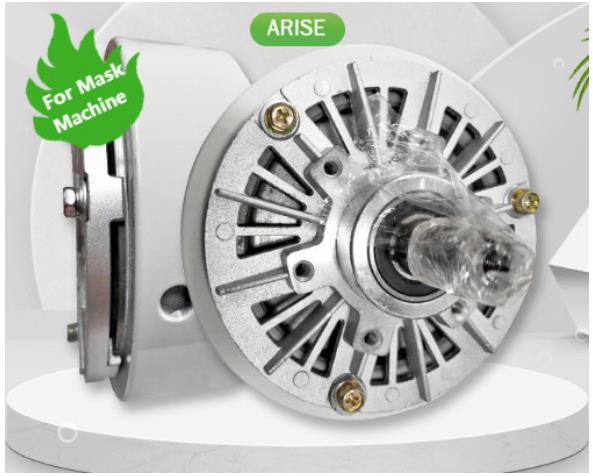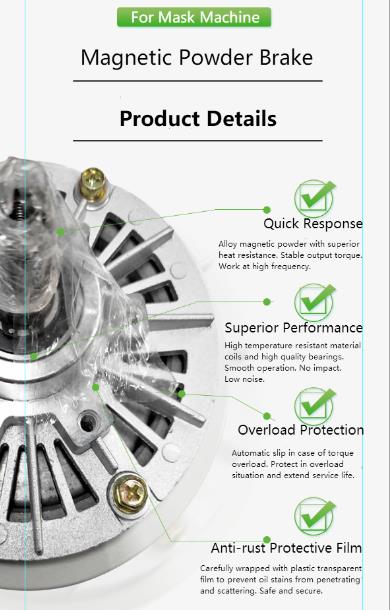Magnetic powder brakes are versatile devices that are commonly used in industrial applications requiring precise and smooth torque control. Printing, packaging, web tension control, and automotive are just a few of the industries that use them. In this post, we will look at the fundamental concepts, components, and benefits of magnetic powder brakes.

Working Principle Of Magnetic Powder Brake
A magnetic powder brake functions on the magnetorheology principle, which is the phenomenon in which the rheological properties of a material change in reaction to an applied magnetic field. The magnetic powder, which is a tiny particulate substance with magnetorheological behavior, is the most important component of a magnetic powder brake. Magnetic powder is often made up of microscopic magnetic particles spread in a non-magnetic carrier material.
A magnetic powder brake is composed of two principal components: a rotor and a stator. The rotor is connected to the input shaft and driven by the motor or another energy source, whilst the stator is connected to the output load. A coating of magnetic material exists between the rotor and the stator. When the brake is applied, the rotor and stator come into contact, and the magnetic powder is exposed to a magnetic field.
The magnetic field is created by an electromagnet mounted on the stator. A magnetic field penetrates the magnetic powder when an electric current travels through the coil. The powder solidifies and transmits torque between the rotor and stator because the magnetic particles in the powder align with the magnetic field. This allows for precise and smooth braking torque management.The torque level of the magnetic powder brake can be varied by varying the current supplied to the coil.
By varying the strength of the magnetic field, the rheological properties of the magnetic powder can be altered, resulting in varied levels of torque transmission. Magnetic powder brakes are ideal for applications requiring precise and smooth torque control because they enable for precise control of the braking torque.
Components of Magnetic Powder Brake
Rotor
The rotor is the input component of the brake, and it is connected to the motor or power source. When the brake is applied, a cylindrical or disc-shaped component usually rotates.
Stator
The brake's output component, the stator, is connected to the load. It is typically stationary and houses the coil or electromagnet that generates the magnetic field.
Magnetic Powder
The magnetic powder is used to transmit torque between the rotor and stator. It is composed of tiny magnetic particles suspended in a nonmagnetic carrier material such as oil or grease.
Coil or Electromagnet
The coil, also known as an electromagnet, generates the magnetic field that solidifies the magnetic material and transmits torque. It is typically mounted on the stator and is powered by an external source.

Advantages Of Magnetic Powder Brake
Smooth and precise torque control
By providing smooth and precise torque control, magnetic powder brakes provide accurate and consistent braking performance. The braking torque may be easily managed by varying the current supplied to the coil, allowing fine-grained control over the braking process. Precision speed and tension control is possible in printing, packing, and web tension management applications.
High accuracy and repeatability
Magnetic particle powder brakes are suited for applications that require precise and consistent braking performance due to their high torque control accuracy and repeatability. This is especially important in applications where the quality of the finished product is dependent on consistent tension management, such as printing, laminating, and coating.
Wide torque range
Depending on the size and design of the brake, magnetic powder brakes can function throughout a wide range of torque values, ranging from extremely low to very high torque levels. Because of their torque capacity versatility, they are suited for a wide range of applications, from small-scale to heavy-duty industrial processes.
Fast response time
Magnetic powder clutch brakes respond quickly, providing for fast braking torque engagement and disengagement. As a result, they are well suited for high-speed printing and packaging processes that require fast torque changes.
Overload protection
Magnetic powder brakes can protect driven equipment from overburdening. The magnetic powder brake slips when the torque exceeds the specified limit, preventing equipment damage and ensuring safety.
Noiseless operation
Magnetic powder brakes operate quietly, with no noise or vibrations, making them excellent for applications that require quiet operation, such as printing or packaging.
Compact and lightweight design
Magnetic powder clutch brakes feature a compact and lightweight design that allows them to be easily integrated into a variety of machine systems without adding unnecessary weight or space.
Customizable
The custom magnetic powder brakes can be applied to specific application needs, such as torque capability, response time, and mounting options. As a result, they are a versatile option for a variety of industrial applications.